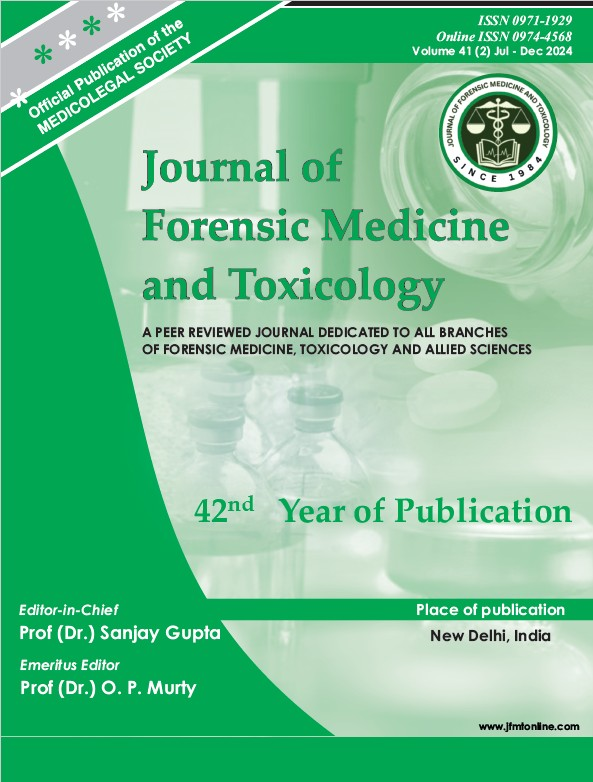EVALUATION OF ELECTROLYTES LEVEL IN PERICARDIAL FLUID AFTER DEATH AND ITS CORRELATION WITH TIME SINCE DEATH
Keywords:
Time since death, Postmortem interval, Electrolytes, Pericardial fluidAbstract
Background: One of the key objectives of a medicolegal autopsy is to ascertain the exact time of death. Traditionally, the early and late postmortem changes are used to estimate the time since death. There is still a need to develop a suitable method to determine the time since death because these postmortem changes may be impacted by external as well as internal variables. The objective of the present study was to determine the correlation between the concentration of sodium, potassium, calcium, and phosphate in pericardial fluid after death and the passage of time.
Material and Methods: A sample of pericardial fluid was collected from the deceased who was brought in for a medicolegal autopsy. The pericardial fluid’s electrolyte content primarily that of sodium, potassium, calcium, and phosphate, was assessed. Based on the amount of time since death, the deceased were grouped. To determine the relationship between the electrolyte concentration and the time since death, log transferred regression analysis was used, and regression formulas were created for each parameter. Results: Time since death was negatively correlated with sodium concentration. Potassium, calcium, and phosphate levels correlated positively with time since death. There was no significant variation in electrolyte concentration between males and females. Between the age categories, there was no discernible variation in sodium, potassium, or phosphate levels. Conclusion: The measurement of electrolyte levels in the pericardial fluid following death suggested that the change in electrolyte level direction, whether rise or decrease, persisted for at least 36 hours and maybe up to 48 hours after death. Following that, the changing trend swung the other way. The time since death can be estimated by the electrolyte levels in the pericardial fluid.
Downloads
References
Swain R, Kumar A, Sahoo J, Lakshmy R, Gupta SK, Bhardwaj DN, et al.: Estimation of post-mortem interval: A comparison between cerebrospinal fluid and vitreous humor chemistry. J Forensic Leg Med. 2015, 36:144-8. 10.1016/j.jflm.2015.09.017
Kaliszan M, Hauser R, Kernbach-Wighton G: Estimation of the time of death based on the assessment of post-mortem processes with emphasis on body cooling. Leg Med. 2009, 11:111-7.10.1016/ j.legalmed.2008.12.002
Ferreira MT, Cunha E : Can we infer postmortem interval on the basis of decomposition rate? A case from a Portuguese cemetery. Forensic Sci Int. 2013, 226: 298.e1-6.10.1016/j.forsciint.2013.01.006
Garg SDP, Arora A, Dubey BP: A study of serum enzymal changes after death and its correlation with time since death. J Indian Acad Forensic Med. 2005, 27:16-8.
Trivedi D, Narayana KS: Postmortem blood glucose level: How useful to envisage the time since death. Int J ClinBiochem Res. 2015, 2:61-4.
Srirangarajan S, Sindhu V, Raju S, Rao RJ: Evaluation of gingival tissue sample for predicting the time of death using histology and biochemical tests. Forensic Sci Int. 2021, 324:1-5.10.1016/ j.forsciint.2021.110850
Siddamsetty AK, Verma SK, Kohli A, Puri D, Singh A: Estimation of time since death from electrolyte, glucose and calcium analysis of postmortem vitreous humor in semi-arid climate. Med Sci Law. 2014, 54:158- 66.10.1177/0025802413506424
Balasooriya BA, St Hill CA, Williams AR: The biochemical changes in pericardial fluid after death. An investigation of the relationship between the time since death and the rise or fall in electrolyte and enzyme concentrations and their possible usefulness in determining the time of death. Forensic Sci Int. 1984, 26:93-102.10.1016/0379-0738(84)90065-3
Singh D, PrashadR, Sharma SK, Pandey AN: Estimation of postmortem interval from human pericardial fluid electrolytes concentrations in Chandigarh zone of India: Log transformed linear regression model. Leg Med. 2006, 8:279-87. 10.1016/ j.legalmed.2006.06.004
Kawamoto O, Michiue T, Ishikawa T, Maeda H. Comprehensive evaluation of pericardial biochemical
markers in death investigation. Forensic Sci Int. 2013, 224:73-9. 10.1016/j.forsciint.2012.10.036
Sharma SK. Pericardial fluid biochemistry for the estimation of time since death: A prospective study. J Forensic Med Toxicol. 2018, 35:32-8.10.5958/0974- 4568.2018.00007.8
Gurumukhi J, Sinha A, Rani Y, Sharma GK: A study of potassium level in pericardial fluid for estimation of time since death. J Forensic Med Toxicol. 2000, 17:1-4.
Niranjan S, Shubhankar M, Kumar PK: Estimation of time since death with changes in potassium level in pericardial fluid. Indian J Applied Res. 2015, 5:215-7.
Li DR, Quan L, Zhu BL, Ishikawa T, Michiue T, Zhao D, et al.: Evaluation of postmortem calcium and magnesium levels in the pericardial fluid with regard to the cause of death in medicolegal autopsy. Leg Med. 2009, 11: S276-8. 10.1016/j.legalmed.2009.01.028




